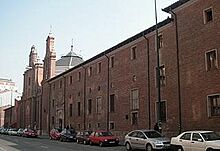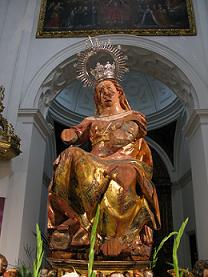English College, Valladolid facts for kids

The façade of the College
|
|
| Type | Seminary |
|---|---|
| Established | 1589 |
|
Religious affiliation
|
Roman Catholic |
| Rector | Fr John Flynn |
| Location | , |
| Website | http://www.sanalbano.org/ |
The Royal English College (in Spanish: Real Colegio de Ingleses) is a special school in Valladolid, Spain. It helps young men from England and Wales who want to become priests. The college is named after St Alban, a very old saint.
Students usually spend a year here to think about their future and begin their training. After this year, they often go to other schools in the United Kingdom, Ireland, or Rome to continue their studies.
Contents
History of the College
How the College Started
The Royal English College was founded in 1589 by Robert Persons. He was an English Jesuit priest. He started the college with permission from King Philip II of Spain. This happened during a time called the English Reformation.
Changes Over Time
The Jesuits ran the college until 1767. At that time, they had to leave Spain. This caused a big problem for the college. There were no teachers or students left.
But a bishop named Richard Challoner helped save the college. He brought together three other English colleges in Spain. He also found new teachers and students. The college also received money and items from another college that had closed.
Modern Role of the College
In 1998, the Catholic Bishops' Conference of England and Wales supported the college. They made it a special place for an introductory year of studies. This was encouraged by Pope John Paul II. This means the college helps students prepare for their journey to become priests.
Our Lady Vulnerata
The Story of the Statue
In the college chapel, there is a special statue of Our Lady. It is called La Vulnerata, which means The Wounded One. The story of this statue is very old.
In 1596, English ships led by the Earl of Essex and Sir Walter Raleigh attacked the city of Cadiz in Spain. During the attack, English soldiers took a statue of the Virgin Mary and Child from a church. They damaged it, breaking off its arms. Only parts of the child's feet were left on its mother's knee.
The Statue's Journey
The damaged statue was taken to Madrid. A Countess kept it in her private chapel. The priests and students at the English College in Valladolid heard about the statue. They asked the Countess if they could take it. They wanted to show respect for the statue after it had been damaged by their fellow countrymen.
The Countess agreed. In 1600, the statue was brought to Valladolid. It was placed in the college chapel with a special ceremony.
Annual Procession
Every year during Holy Week, the statue is carried in a procession through the street. It meets a huge float called a paso. This float has a large image of the Crucified Christ. The two images meet and seem to "dance" for a short time. Then, the Vulnerata statue returns to the college.
College Martyrs
Many former students of the college were martyred. This means they died for their beliefs during the Protestant Reformation in England and Wales.
- Saint Ambrose Barlow OSB
- Saint Thomas Garnet SJ
- Saint John Lloyd
- Saint John Plessington
- Saint John Roberts OSB
- Saint Henry Walpole SJ
- Blessed Ralph Ashley SJ
- Blessed Edward Bamber
- Blessed Mark Barkworth OSB
- Blessed Arthur Bell OSF
- Blessed Thomas Benstead
- Blessed Thomas Bullaker OSF
- Blessed Roger Cadwallador
- Blessed Ralph Corby SJ
- Blessed Robert Drury
- Blessed Roger Filcock SJ
- Blessed Thomas Holland SJ
- Blessed Thomas Palaser OSF
- Blessed Thomas Reynolds
- Blessed William Richardson
- Blessed William Southerne
- Blessed Thomas Whitaker
- Venerable Edward Morgan SJ
See also
- English College, Douai
- English College, Rome
- List of Jesuit sites


